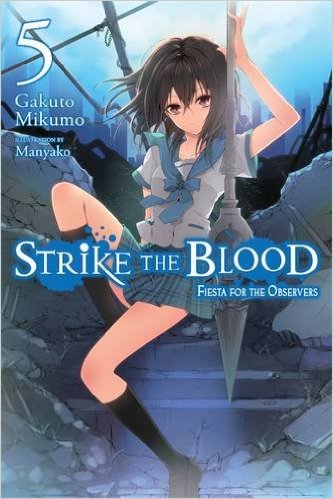By Gakuto Mikumo and Manyako. Released in Japan by ASCII Mediaworks. Released in North America by Yen On. Translated by Jeremiah Bourque.
As always, Strike the Blood does what it wants competently and efficiently, with good pacing and a nice balance between the hero and his various female leads. And yet it continues to be one of the most frustrating light novel series that I follow, because it is content to be simply that. There’s potential for a lot more here, and at times the series looks as if it’s going to show you that potential… and then it backs off, content to give us a comedic perverted parent, or a bath scene with a giant nosebleed, or Yukina saying her catchphrase again with all the well-crafted timing of a Swiss watch. Strike the Blood is what it is, and thus I will never get to experience what I have with most other cliched light novel series, which is the joy of seeing the books get better as they go along.
This is the second half of a two-part arc, and as such we hit the ground running, with less development and more fights. Sadly, this also means less development for Yuuma, who is injured enough to be shunted to the side for the majority of the book, until the climax where she shows up to use her clone status against her mother. There is talk of the idea of her being a disposable tool being wrong, which would probably read a lot better of the author weren’t treating her like a disposable tool, using her to help resolve things at the climax and then cheerfully writing her out to go serve time as an accessory. We also finally meet Kojou’s mother, who is unaware (possibly) that he is a vampire now, and is an absurdly youthful genius doctor mom who has a tendency to feel up girls for fun. I called this “TV Tropes: The Novel” last time, and that hasn’t changed. His mother is there to provide gropes and exposition, and stop Yuuma from dying.
As for the plot itself, as the villain cheerfully admits, half of it is an excuse for a giant runaround using minibosses to build up tension but never actually do much beyond sort of threaten the hero and heroines and then get dealt with. I was happy to see Asagi get something more substantial to do – she remains my favorite of the three main heroines, and her solution to the first miniboss battle showed off her smarts (with the help of her AI that controls the entire island). Sadly, the main villain herself is less interesting, which is especially irritating as she didn’t have to be. There’s suggestion of a deeper story between her and Natsuki, and we even see a brief flashback, but it’s just spice to show why she hasn’t merely killed everyone before this. If we’d gotten an entire chapter devoted to Natsuki and Aya’s school days and what led to her descent into mad villainy, I might have praised it. But we don’t.
I keep hoping this will get bad enough for me to drop, but it’s far too efficient for that. It has dropped a new novel in our laps, and we will read it, vaguely enjoy it, be disappointed at what could have been, adn then forget about entirely until the next book. Sigh.

